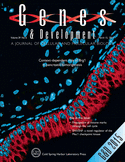 Two identical retraction notices have popped up for MIT professor Robert Weinberg, a highly-cited cancer researcher who had a retraction and a correction in 2013, both in Cancer Cell.
Two identical retraction notices have popped up for MIT professor Robert Weinberg, a highly-cited cancer researcher who had a retraction and a correction in 2013, both in Cancer Cell.
These two new retractions, in Genes and Development, stem directly from another paper by Weinberg and colleagues in Cell that will apparently be retracted, as the “same analytical methodology was used,” according to the notices [see bottom of the post for an update].
Weinberg is highly regarded, and at least 20 of his papers have been cited over a thousand times.
First author Scott Valastyan was a promising postdoc at the time of the paper’s publication. He was a 2011 Runyon Fellow at Harvard, a three-year, $156,000 award for outstanding cancer postdocs. He doesn’t seem to have published anything since 2012, though he is listed as a joint inventor with Weinberg on patents filed in 2009 and 2014.
Here are the notices for “Concomitant suppression of three target genes can explain the impact of a microRNA on metastasis” (cited 73 times, according to Thomson Scientific’s Web of Knowledge) and “Activation of miR-31 function in already-established metastases elicits metastatic regression” (cited 54 times), both paywalled:
“Our study investigated the mechanisms by which miR-31 regulates different aspects of breast cancer metastasis. We have retracted our earlier publication involving miR-31 (Valastyan et al. 2009) because original data were compiled from different replicate experiments in order to assemble certain figure panels. As the same analytical methodology was used in this manuscript, we believe that the responsible course of action is to retract the article. We apologize for any inconvenience we have caused.”
The cosigners of this retraction are the same set of coauthors as that of the Genes & Development article.
We’ve reached out to Valastyan, Weinberg, and the journal, and will update if we hear back.
Update 1:34 p.m. EST 3/19/15: A spokesperson for Cell confirmed that the 2009 paper, which has been cited 480 times, would be retracted:
At this time, I can only confirm that the paper referenced by Genes & Development is being retracted and Cell’s official notice is forthcoming. I will make sure you receive the notice as soon as it is available.
In addition, we corrected the second paragraph of this post to make it clear which paper these retractions are based on.
Update 5:15 p.m. EST 3/19/15: Genes and Development publisher John Inglis told us in accordance with journal policy, the paywalls have been removed from the retractions. He declined to comment further.
Hat tip: Jonathan Weitzman
Earlier cases did not feature Scott Valastyan at all, but a person named Annapoorni Rangarajan:
http://retractionwatch.com/2013/09/12/a-cancer-cell-mega-correction-for-highly-cited-researcher-who-retracted-paper-earlier-this-year/
http://retractionwatch.com/2013/01/15/leading-cancer-researcher-retracts-2003-paper-for-inappropriate-presentation/
Possibly two rogue postdocs, but maybe high pressure to publish in high impact journals may have been involved as well.
This paper features neither Valasyan nor Rangarajan: https://pubpeer.com/publications/15210113
I have to say, as someone who has been deeply influenced for more than 20 years by Bob Weinberg’s work, that I am heartbroken over these retractions. It’s not their existence that is so troubling but their extreme opacity, particularly in light of the convoluted correction issued to the 2009 Cell paper, which seemed to point to mere errors in figure assembly. Perhaps I misjudged his character from afar, but I have always viewed Weinberg as someone who has unabashedly served science more than his own career. As such, I would have expected that he provide greater clarity into the reason for these retractions, rather than this risk management office-tempered language about flawed “analytic methodology.”
So in plain English, they cherry picked data from different experiments and made it look like they came from the same experiment? If so, “analytical methodology” is a very original euphemism for falsification.
Yes, “analytical methodology” made me think that the problem was in some technical procedure.
Maybe the phrase they were looking for is “publishing ethics”?
I do not grasp the reason for the retraction. One usually “compiles different replicate experiments” in order to have an statistical analysis of the data, isn’t it?
Like Pablo, I’m confused about the basis for this retraction. If you run the same experiment multiple times, it’s still the same experiment. There is no expectation that all the data shown (images, I’m assuming, because graphs would show aggregate data with statistics) is from one trial.
Unless what they mean is that they did the experiment multiple times, and different subsets of those replicates were used in different panels. That’s clearly mis-representing the data.
I was going to write “The figures contain a number of immuno-histology images – cherry picking (“compiled from different replicate experiments”) might indicate that e.g. treatment and controls from different experiments were used in order to give the impression of a stronger effect than actually observed.”
just now I had a nother look at the Genes & Dev paper, and have to agree that the bar plots supposedly represent cumulative data from replicate experiments… Makes for one strange case of a retraction notice. But I guess that there is quiet a bit of obfuscation going on in order to deflect any suspicions of misconduct…
I don’t know the lead researcher but noticed he won the Wolf Prize in Medicine in 2004 and is a member of the U.S. National Academy of Sciences. Though unclear at this point, if postdocs were responsible, it serves as a cautionary tale – be vigilant! The most innocent seeming postdoc, staff scientist, or graduate student may be manipulating data or doing other bad things behind your back! Double check everything! The lab director is ultimately responsible!